The Significance of Samhain and Tlachtga in Celtic Tradition
Samhain, celebrated on November 1st, is a festival that signifies the “end of summer” and represents the conclusion of the Celtic year with the arrival of winter. October 31st marks a time of deep reflection as both ancestors and the living intersect in a mystical realm.
Traditionally, the night of Samhain is when it was believed that the spirits of one’s forebears would traverse the boundaries of time to visit the living. To avoid recognition and potential interference from these spirits, people would don masks and costumes. The encroaching darkness of night was often a cause of trepidation, as it heightened fears of lurking supernatural entities.
Samhain was also historically a moment for reconciliation, with warring factions halting conflicts to foster peace. It was a period for assessing one’s endeavours and clearing any debts. Horse and chariot races provided entertainment and diversion during this reflective time.
As Oiche Shamhna arrived, all fires were extinguished, rendering it the darkest night of the year. However, these fires would be re-ignited, symbolizing the advent of the new year.
In ancient Ireland, the Hills of Tara and Tlachtga held considerable importance. Tara is recognized as the ancestral seat of the High Kings of Ireland. The druids were known to kindle a massive bonfire on the Hill of Tlachtga (located near Athboy in County Meath), from where torches would be ceremonially distributed to homes throughout the night. The distance separating Tlachtga from Tara is approximately thirteen miles.
Tlachtga served as a significant religious site for Celtic worship over two millennia ago, despite being eclipsed by its illustrious neighbor, Tara. It was renowned for the Great Fire Festival that heralded the onset of winter.
The Great Fire Festival
At Tlachtga, ancient rites and ceremonies reassured the people that the forces of darkness could be dispelled, allowing the forces of light and life to flourish anew. This site was pivotal in honoring the Celtic sun god at the end of the annual cycle.
The festivities surrounding this occasion likely lasted several days, dedicated to the god Lugh. The name Tlachtga originates from the daughter of the druid Mug Ruith, who tragically died giving birth to triplets on this hill. Her name and story are deeply intertwined with Celtic mythology, as the theme of triple births frequently recurs in these narratives.
With the integration of Christianity, the customs surrounding Samhain adapted to align with Christian values, evolving into a remembrance period for holy souls. Aspects of the traditional Samhain festival persisted, leading to the creation of modern Halloween, which Irish immigrants introduced to North America during the 19th century.
The Enigmatic Tlachtga
Tlachtga herself is a notable figure — she accompanied her father on journeys around the globe, absorbing knowledge of magical practices and divine stones from Italy. They traveled utilizing an ancient flying device known as the “oared wheel.” Tlachtga bore triplets from three different fathers on the hill named in her honor. Her tale, marked by emotional depth, mirrors other prominent stories within Celtic folklore, such as that of Macha from Navan, Armagh.
The Luigni tribe, believed to have introduced her as a fertility goddess, coincidentally faced displacement from the Lagin invaders. Over time, the focus of power shifted from Tlachtga to the Hill of Tara.
Also referred to as the Hill of Ward, Tlachtga hosted a prominent ring fort associated with various local rulers. In 1168, the High King Ruaidri Ua Conchobair organized a grand assembly at Tlachtga. Mug Ruith, a legendary druid famed for his formidable stature and magical prowess, became synonymous with this site. His mythos includes extraordinary abilities like storm creation and petrification.
Archaeological Significance of the Hill of Ward
The earthworks present on the Hill of Ward demonstrate a significant level of activity dating back about 2,000 years, and they reveal remnants of much earlier ritualistic practices. The hill’s English title stems from a landowner named Ward, whose lineage was noted for its association with the area.
Recent archaeological efforts at Tlachtga have unearthed signs of intense burning dating back to 500 AD, with noteworthy discoveries including a child’s skeleton found within one of the burial chambers. Archaeologist Dr. Steve Davis has indicated that this site may have been purposefully obscured from early Christian narratives.
In recent years, Tlachtga has regained attention with torch-lit parades commemorating Samhain. These celebrations connect past traditions and mythology, reaffirming the cycle of life, death, and rebirth as communities honor their history.
As you immerse yourself in the tales woven throughout the Samhain celebration, remember to don a costume should you wish not to be recognized by the ethereal connections of the past, for they might still linger in search of recognition.



